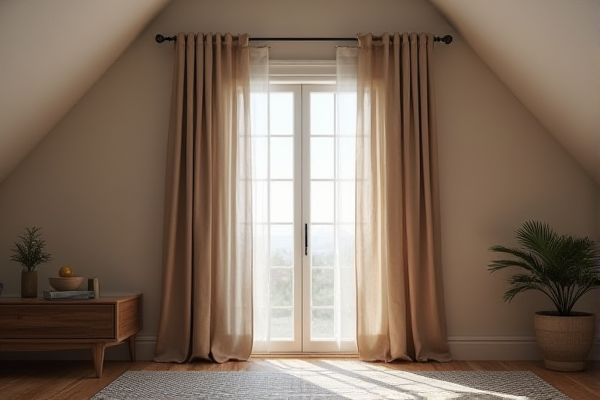
Attic blackout curtains are designed primarily to block light and reduce glare, enhancing visibility and comfort in your attic space, while insulated curtains focus on maintaining temperature by preventing heat loss or gain, improving energy efficiency. Discover which curtain type best suits your attic needs by exploring the advantages and features detailed in the rest of this article.
Table of Comparison
| Feature | Attic Blackout Curtain | Insulated Curtain |
|---|---|---|
| Purpose | Blocks sunlight completely, ideal for darkening attic spaces | Provides thermal insulation, reduces heat loss and gain |
| Material | Heavy, opaque fabric (e.g., triple-weave or polyester) | Multi-layered fabric with insulating foam or thermal backing |
| Energy Efficiency | Minimal energy savings, focuses on light blockage | Improves energy efficiency by maintaining indoor temperature |
| Light Control | 100% blackout capability | Partial light filtering, depends on fabric thickness |
| Best Use | Bedrooms, media rooms, attic windows for light control | Living spaces, attics for temperature control and comfort |
| Cost | Moderate, varies by fabric quality | Generally higher due to insulation layers |
| Installation | Standard curtain rod or track installation | May require heavier-duty rods due to weight |
Understanding Attic Blackout Curtains
Attic blackout curtains are specifically designed to block out sunlight completely, creating a dark environment ideal for improved sleep and reducing glare. Unlike insulated curtains, which focus on temperature regulation by reducing heat transfer, blackout curtains prioritize light control with dense, opaque materials. You can enhance comfort and energy savings by selecting an attic blackout curtain tailored to your light-blocking needs.
What Are Insulated Curtains?
Insulated curtains are designed with multiple layers, typically featuring thermal linings that reduce heat transfer through windows, enhancing energy efficiency and comfort. Unlike standard blackout curtains, which mainly block light, insulated curtains provide superior temperature regulation by minimizing heat loss in winter and heat gain in summer. Their construction often includes materials like foam or reflective foils, making them ideal for attic spaces requiring better insulation alongside light control.
Key Differences: Blackout vs Insulated Curtains
Blackout curtains are designed primarily to block out light, making them ideal for creating dark environments in attic spaces, while insulated curtains focus on enhancing thermal efficiency by reducing heat loss and maintaining indoor temperatures. You benefit from blackout curtains when minimizing light intrusion is the priority, whereas insulated curtains provide superior energy savings by improving insulation against cold or heat. The key difference lies in blackout curtains prioritizing light control and privacy, whereas insulated curtains emphasize temperature regulation and energy efficiency.
Energy Efficiency Comparison
Attic blackout curtains block sunlight and reduce heat gain, improving energy efficiency by lowering cooling costs during summer, while insulated curtains feature thermal lining that minimizes heat transfer, enhancing both heating and cooling energy savings year-round. Insulated curtains provide superior performance in maintaining consistent indoor temperatures, reducing reliance on HVAC systems more effectively than regular blackout curtains. Choosing insulated curtains maximizes energy efficiency through thermal regulation, making them ideal for attics exposed to extreme temperature fluctuations.
Light Blocking Capabilities
Attic blackout curtains provide superior light blocking capabilities by using dense, multi-layered fabrics that prevent nearly 100% of sunlight penetration, making them ideal for creating complete darkness in rooms. Insulated curtains, while designed primarily for thermal regulation with materials like foam or thermal linings, offer moderate light blocking but generally allow some light to filter through due to their focus on energy efficiency rather than total blackout. Choosing between the two depends on whether the priority is absolute light elimination for activities like sleeping or light filtering combined with temperature control.
Temperature Regulation in Attics
Attic blackout curtains primarily block sunlight to reduce heat gain, helping maintain cooler temperatures during hot weather. Insulated curtains offer superior temperature regulation by adding a thermal barrier that retains heat during winter and blocks heat in summer, improving attic energy efficiency. Effective use of insulated curtains in attics can lower heating and cooling costs by stabilizing interior temperatures year-round.
Installation and Maintenance
Attic blackout curtains typically feature lightweight materials with easy-to-mount rods or hooks, enabling quick installation and straightforward removal for cleaning, making them ideal for spaces with frequent adjustments. Insulated curtains often incorporate heavier, multi-layered fabrics with thermal lining, requiring sturdier mounting hardware and more cautious handling during installation to maintain their energy-saving properties. Maintenance for insulated curtains involves gentle cleaning methods to preserve insulation effectiveness, whereas blackout curtains allow for more flexible care options due to simpler fabric construction.
Cost Considerations
Attic blackout curtains typically cost less than insulated curtains due to simpler materials designed primarily to block light rather than provide thermal regulation. Insulated curtains, often made with multiple layers including thermal backings, usually have higher upfront costs but can lead to energy savings by improving heat retention and reducing cooling needs. Choosing between the two depends on budget constraints and the desired balance between initial investment and long-term energy efficiency.
Popular Materials and Designs
Attic blackout curtains commonly feature dense polyester or triple-weave fabrics designed to block out sunlight completely, often including a thermal lining that enhances insulation. Insulated curtains are typically constructed with multiple layers and materials such as foam backing, thermal polyester, or acrylic coatings to improve energy efficiency by retaining heat or blocking cold air. Your choice between attic blackout and insulated curtains should consider both material density for light control and layered designs for temperature regulation specific to your attic space.
Which Curtain Is Best for Your Attic?
Attic blackout curtains excel at blocking light, making them ideal for spaces where darkness is crucial, such as bedrooms or home theaters. Insulated curtains provide superior thermal regulation by reducing heat loss in winter and heat gain in summer, enhancing energy efficiency in the attic. Choosing the best curtain depends on whether your primary need is light control or temperature insulation.
 homyna.com
homyna.com